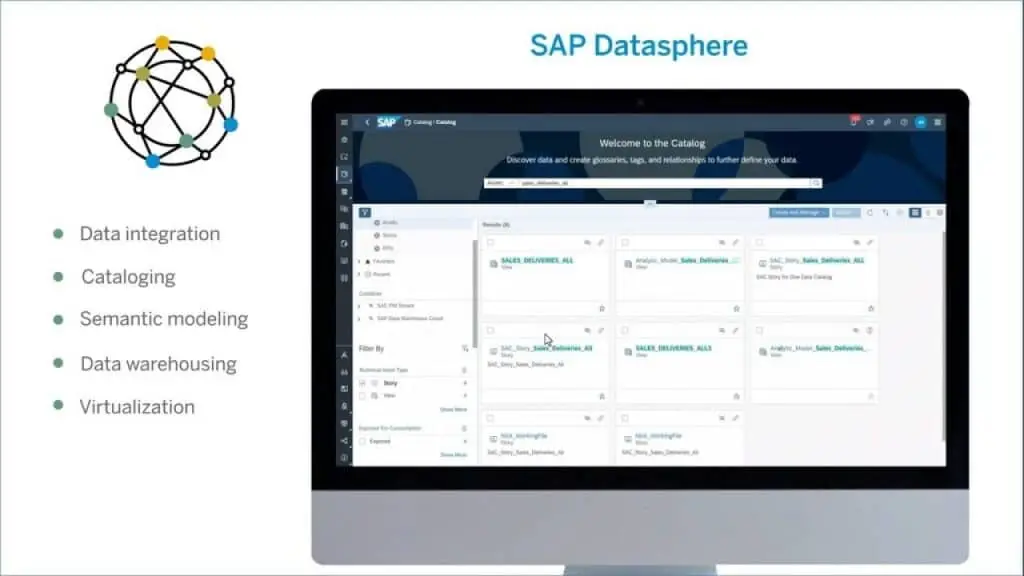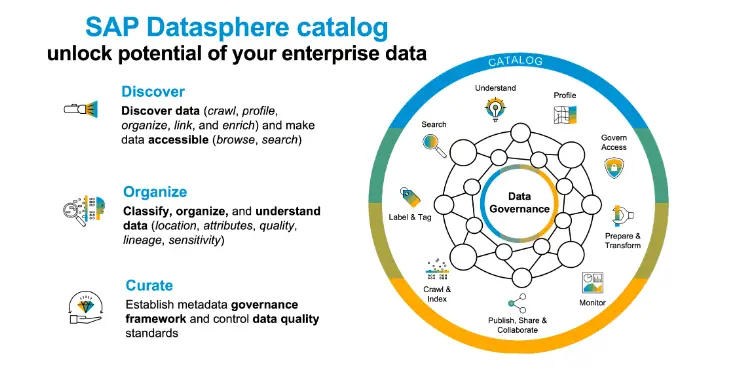Unlocking the Future of Enterprise Data Management
As businesses become more data-driven, the ability to effectively manage, integrate, and analyze data has become a critical competitive advantage. SAP DataSphere offers a comprehensive solution for businesses looking to unify and optimize their enterprise data strategy. Built on the SAP Business Technology Platform (BTP), DataSphere empowers organizations to break down data silos, streamline operations, and gain actionable insights in real-time.
This guide provides an in-depth overview of SAP DataSphere, including its core functionalities, benefits, and use cases across industries.

What is SAP DataSphere?
SAP DataSphere is a cloud-based, enterprise-grade data management solution designed to unify data across diverse sources while ensuring accessibility, governance, and scalability. Acting as a virtual data layer, it provides a single, trusted view of all enterprise data—whether it resides in SAP systems, third-party platforms, or on-premise databases.
Key components of SAP DataSphere include:
- Data Integration: Seamlessly connect SAP and non-SAP systems, cloud platforms, and external data sources.
- Data Orchestration: Harmonize and manage data flows for operational and analytical use cases.
- Data Cataloging: Discover and manage data assets across the organization.
- Data Governance: Ensure compliance and maintain data quality with advanced governance features.
- Real-Time Analytics: Power decision-making by delivering live data to tools like SAP Analytics Cloud.

Core Functionalities
- Unified Data Connectivity
SAP DataSphere allows businesses to integrate data from multiple sources, including SAP S/4HANA, SAP BW/4HANA, third-party ERPs, and cloud storage platforms like AWS and Google Cloud. This eliminates silos and ensures a comprehensive, 360-degree view of the organization.
- Live Data Access
Unlike traditional data warehousing solutions that rely on replication, SAP DataSphere provides live connectivity, enabling real-time insights without duplicating data. This ensures decisions are based on the most up-to-date information.
- Data Governance and Security
With built-in governance capabilities, SAP DataSphere ensures data quality, consistency, and compliance with regulatory frameworks like GDPR and IFRS. Role-based access controls allow organizations to enforce security while enabling self-service analytics.
- Integration with SAP Analytics Cloud
SAP DataSphere integrates seamlessly with SAP Analytics Cloud (SAC), allowing users to create advanced dashboards, predictive models, and KPI trackers powered by harmonized data.
- Scalability and Flexibility
As a cloud-native platform, SAP DataSphere adapts to growing data volumes and evolving business needs, making it ideal for organizations embarking on digital transformation journeys.
Business Benefits
Accelerated Decision-Making
By providing real-time, unified access to enterprise data, SAP DataSphere enables faster, data-driven decisions. Teams can quickly identify opportunities, manage risks, and adapt to market changes.
Reduced Complexity
SAP DataSphere simplifies the data management landscape by consolidating fragmented systems and automating integration processes. This reduces IT overhead and allows teams to focus on strategic initiatives.
Improved Collaboration Across Teams
With a single source of truth, SAP DataSphere promotes collaboration between finance, operations, and other departments, ensuring alignment between operational and strategic goals.
Regulatory Compliance and Transparency
SAP DataSphere helps businesses adhere to regulatory standards like GAAP, IFRS, or GDPR by ensuring data integrity and auditability. Automated workflows reduce the risk of errors in financial reporting.
Enhanced Agility
The flexibility of SAP DataSphere allows businesses to scale seamlessly as data needs evolve. Organizations can easily integrate new data sources, adopt emerging technologies, and respond to dynamic market demands.Lorem ipsum dolor sit amet, consectetur adipiscing elit. Ut elit tellus, luctus nec ullamcorper mattis, pulvinar dapibus leo.
Industries Leveraging
SAP DataSphere is widely adopted across various industries, offering tailored solutions for sector-specific challenges:
Manufacturing: Optimize production planning and supply chain logistics with real-time operational data.
Retail: Centralize customer, sales, and inventory data to improve demand forecasting and personalized marketing.
Financial Services: Streamline financial consolidation, enhance regulatory compliance, and improve risk assessment.
Healthcare: Harmonize patient data for better care delivery and operational efficiency.
Energy and Utilities: Monitor asset performance and streamline maintenance using unified data insights.
Public Sector: Ensure data transparency for reporting, compliance, and public engagement initiatives.
- Financial Planning and Consolidation
Harmonize financial and operational data to create integrated plans, automate intercompany eliminations, and streamline financial consolidation.
- Data-Driven Decision-Making
Enable real-time decision-making across all business units by providing access to live, harmonized data.
- Predictive Analytics
Use SAP DataSphere as the foundation for predictive forecasting and advanced analytics in SAP Analytics Cloud, helping businesses identify trends and model future scenarios.
- Supply Chain Optimization
Integrate supply chain data to improve demand forecasting, inventory management, and supplier collaboration.
- Compliance and Audit Readiness
Ensure adherence to financial reporting standards and regulatory frameworks through automated workflows and robust governance tools.
SAP DataSphere provides a robust framework to integrate a wide range of SAP and non-SAP systems, enabling organizations to unify data across their enterprise seamlessly. Below is an overview of the key supported connections:
SAP System Connections
- SAP S/4HANA: Live connectivity to financial, operational, and transactional data for real-time insights.
- SAP BW/4HANA: Integration with existing data warehouses to enhance analytics capabilities.
- SAP HANA Cloud: Seamlessly integrate with SAP’s cloud-native database for high-performance analytics.
- SAP SuccessFactors: Combine HR and workforce data with operational metrics for better workforce planning.
- SAP Ariba: Streamline procurement analytics by connecting supplier and purchasing data.
- SAP Concur: Integrate travel and expense data to enhance budget and financial visibility.
Non-SAP System Connections
- Third-Party ERP Systems: Integrate data from platforms like Oracle NetSuite or Microsoft Dynamics 365.
- Cloud Platforms: Connect to major cloud providers, including:
- AWS (Amazon Web Services)
- Microsoft Azure
- Google Cloud Platform (GCP)
- Databases: Unified access to relational and non-relational databases, including:
- PostgreSQL
- MySQL
- MongoDB
- Snowflake
- Data Warehouses: Incorporate legacy or third-party data warehouses like Teradata, Redshift, or BigQuery.
API and Custom Data Source Integration
- Open Connectors: SAP DataSphere supports open APIs for custom integrations, allowing organizations to bring data from niche systems or homegrown applications into their data fabric.
- REST and OData APIs: Flexibility to pull data from any compatible platform.
File and Streaming Data Sources
- Flat Files: Support for CSV, Excel, and other flat file formats.
- Streaming Data: Integration with real-time data streams via platforms like Apache Kafka or MQTT.
Live vs. Import Connections
Live Connections
SAP DataSphere excels in providing live data access without replication. This ensures up-to-date insights from SAP systems like S/4HANA, SuccessFactors, or BW/4HANA. Live connections are ideal for scenarios requiring real-time data, such as:
- Financial planning and consolidation.
- Operational decision-making.
- Time-sensitive analytics.
Import Connections
For systems where live access isn’t possible or practical, SAP DataSphere supports data import. Imported data is harmonized within DataSphere, making it suitable for long-term reporting and complex data transformations.
Benefits of SAP DataSphere Connections
- Comprehensive Data Integration: Connect data from diverse sources to enable enterprise-wide analytics and planning.
- Reduced Data Silos: Achieve a single source of truth by harmonizing data across SAP and third-party systems.
- Enhanced Agility: Quickly integrate new systems and platforms as your business evolves.
- Scalability: Support large-scale data integration for businesses with complex, global operations.
Setting up SAP DataSphere involves several key steps:
- Connect Data Sources: Link SAP systems (like S/4HANA or SuccessFactors) and third-party platforms (like Salesforce or Azure) using pre-built connectors.
- Define Data Models: Create virtual data models to harmonize and organize data for analytics and operations.
- Enable Governance Rules: Configure data access controls, policies, and quality checks to maintain data integrity.
- Integrate with Analytics: Connect SAP DataSphere to analytics tools like SAP Analytics Cloud or third-party BI platforms to enable actionable insights.
- Monitor and Optimize: Use built-in monitoring tools to track data flows, identify bottlenecks, and enhance performance.
Conclusion: Why SAP DataSphere is the Future of Data Management
SAP DataSphere redefines how businesses approach enterprise data management. By breaking down silos, ensuring real-time insights, and promoting collaboration, it empowers organizations to drive innovation, efficiency, and growth.
Whether your focus is financial planning, operational optimization, or compliance, SAP DataSphere offers the tools and flexibility to transform your enterprise data into a strategic asset.
